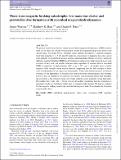Files in this item
There is no magnetic braking catastrophe : low-mass star cluster and protostellar disc formation with non-ideal magnetohydrodynamics
Item metadata
| dc.contributor.author | Wurster, James | |
| dc.contributor.author | Bate, Matthew R. | |
| dc.contributor.author | Price, Daniel J. | |
| dc.date.accessioned | 2019-10-25T11:30:07Z | |
| dc.date.available | 2019-10-25T11:30:07Z | |
| dc.date.issued | 2019-10 | |
| dc.identifier | 262150241 | |
| dc.identifier | ac766a36-1205-482c-bac4-0e0c005a67cb | |
| dc.identifier | 85075127211 | |
| dc.identifier.citation | Wurster , J , Bate , M R & Price , D J 2019 , ' There is no magnetic braking catastrophe : low-mass star cluster and protostellar disc formation with non-ideal magnetohydrodynamics ' , Monthly Notices of the Royal Astronomical Society , vol. 489 , no. 2 , pp. 1719-1741 . https://doi.org/10.1093/mnras/stz2215 | en |
| dc.identifier.issn | 0035-8711 | |
| dc.identifier.other | Bibtex: WursterBatePrice2019 | |
| dc.identifier.other | ORCID: /0000-0003-0688-5332/work/63716929 | |
| dc.identifier.uri | https://hdl.handle.net/10023/18772 | |
| dc.description.abstract | We present results from the first radiation non-ideal magnetohydrodynamics (MHD) simulations of low-mass star cluster formation that resolve the fragmentation process down to the opacity limit. We model 50 M⊙ turbulent clouds initially threaded by a uniform magnetic field with strengths of 3, 5 10, and 20 times the critical mass-to-magnetic flux ratio, and at each strength, we model both an ideal and non-ideal (including Ohmic resistivity, ambipolar diffusion, and the Hall effect) MHD cloud. Turbulence and magnetic fields shape the large-scale structure of the cloud, and similar structures form regardless of whether ideal or non-ideal MHD is employed. At high densities (106 ≲ nH ≲ 1011 cm−3), all models have a similar magnetic field strength versus density relation, suggesting that the field strength in dense cores is independent of the large-scale environment. Albeit with limited statistics, we find no evidence for the dependence of the initial mass function on the initial magnetic field strength, however, the star formation rate decreases for models with increasing initial field strengths; the exception is the strongest field case where collapse occurs primarily along field lines. Protostellar discs with radii ≳ 20 au form in all models, suggesting that disc formation is dependent on the gas turbulence rather than on magnetic field strength. We find no evidence for the magnetic braking catastrophe, and find that magnetic fields do not hinder the formation of protostellar discs. | |
| dc.format.extent | 23 | |
| dc.format.extent | 13990859 | |
| dc.language.iso | eng | |
| dc.relation.ispartof | Monthly Notices of the Royal Astronomical Society | en |
| dc.subject | MHD | en |
| dc.subject | Turbulence | en |
| dc.subject | Protoplanetary discs | en |
| dc.subject | Stars: formation | en |
| dc.subject | ISM: magnetic fields | en |
| dc.subject | QB Astronomy | en |
| dc.subject | QC Physics | en |
| dc.subject | NDAS | en |
| dc.subject.lcc | QB | en |
| dc.subject.lcc | QC | en |
| dc.title | There is no magnetic braking catastrophe : low-mass star cluster and protostellar disc formation with non-ideal magnetohydrodynamics | en |
| dc.type | Journal article | en |
| dc.contributor.institution | University of St Andrews. School of Physics and Astronomy | en |
| dc.identifier.doi | 10.1093/mnras/stz2215 | |
| dc.description.status | Peer reviewed | en |
| dc.identifier.url | https://arxiv.org/abs/1908.03241 | en |
This item appears in the following Collection(s)
Items in the St Andrews Research Repository are protected by copyright, with all rights reserved, unless otherwise indicated.

